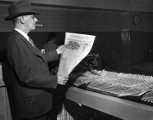Native Virginian
Place of publication: Orange, VA
Located in Virginia's north-central Piedmont region, approximately 85 miles north of Richmond and south of Washington, D.C., Orange is a rural county of fertile land, rolling hills, and Blue Ridge Mountain vistas. Originally inhabited by the Siouan Manahoac tribe, the first European settlement in what would become Orange County was Germanna, composed of twelve German families, in 1741. James Madison's home, Montpelier, is located in Orange County, which was also the birthplace of President Zachary Taylor. According to Frank S. Walker's Remembering: A History of Orange County, Virginia, Orange's location and its rich history resulted in a "veritable flood of local newspapers" over the last two hundred years. Among them was the short-lived Native Virginian, a four-page weekly operated by Alonzo F. Stofer and George W. Bagby in Orange Court House from 1867 until the early 1870s.
In 1867, Stofer established the Orange Expositor (of which no known copies survive), a weekly paper published in Orange Court House. Later that year, after offering Bagby full partnership in the newspaper, the two published volume one, number one of the Native Virginian on November 15, 1867. A well-known journalist, essayist, and humorist, Bagby resided in Litchfield, in a house on the property once belonging to the youngest sister of James Madison. Bagby's career as a newspaperman was long and distinguished, and despite his medical training, journalism was his true calling.
In 1858, Bagby achieved notoriety with his "Mozis Addums" letters published in the Southern Literary Messenger. The humorous letters reflected his impressions of Southern life and focused on "all those character types of the middle and lower social classes ignored or scorned by the complete idealists of sectional literature." In June of 1860, after serving as a correspondent to Southern newspapers in Washington, D.C., Bagby succeeded John Reuben Thompson as editor of the Southern Literary Messenger, and in March 1863 he also served as associate editor of the Richmond Whig. Wartime shortages had a devastating impact on the Messenger, resulting in Bagby's resignation in January 1864, just months before it ceased operations forever.
In 1865 "severe inflammation of the eyes" forced Bagby to temporarily quit journalism. Because of his status as a writer, he was able to earn a living as a lecturer. In his opening editorial in the Native Virginian, Bagby explained, "As a diversion and a means of adding to a literary man's earnings, lecturing does well enough; but as a fixed pursuit it is opened to many objections, and chiefly to this, that it smacks of Yankeeism." Bagby went on to discuss what he wanted his newspaper to be. "For the present the Native Virginian will be simply a country paper," his salutation read, "with the feature of original literary and humorous articles superadded." In the advertising section of the first issue, the Virginian described itself as "A popular humorous paper, devoted to Virginia — her glorious past, and her more glorious future." The first issues also gave a notable portion of copy to John M. Daniel's Latch Key; a Memoir of the late editor of the Richmond Examiner.
Bagby and Stofer moved operations to Gordonsville in 1870, but their efforts to make the newspaper a financial success were in vain. In 1870 Bagby returned to Richmond and became the assistant to the secretary of the commonwealth and state librarian. On January 28, 1870, Stofer put his half-interest in the Virginian up for sale, but apparently it never sold. Sometime in the early 1870s, Stofer changed the name of the Native Virginian to the Piedmont Virginian and moved the paper back to Orange Court House, where it was published until at least 1903.


